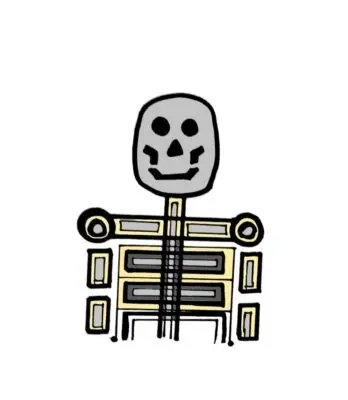
This post contains syllabus of 1st BHMS Human Anatomy syllabus along with their most Important and frequently asked Exam questions from different Indian universities.
Read the whole 1st BHMS syllabus.
This post is prepared for the benefit of the Medical students who are going to appear in the university examinations.
The Paper 1 and Paper 2 divisions are prepared on the basis of syllabus of B.H.M.S. (Degree course) applicable from the academic session 2015-2016, as per the guidelines of Central council of Homoeopathy.
All the questions are given under their related chapters.
- FQ: Full Question
- SFQ: Semi Full Question
- SN: Short Note
The written papers in anatomy shall be in two papers.
Paper 1: Upper Limb, Head, Neck, Face, Brain, Embryology.
Paper 2: Lower Limb, Pelvis, Abdomen, Thorax, Histology.
Read the whole Exam pattern of BHMS.
Table of Contents
ToggleANATOMY PAPER 1
UPPER LIMB
- FQ: Axilla
- FQ: Breast
- FQ: Shoulder joint
- SFQ: Anastomosis around scapula
- SFQ: Brachial plexus
- SFQ: Cubital fossa with its applied anatomy
- SFQ: Deltoid muscle
- SFQ: Flexor Retinaculum
- SFQ: Ulnar Artery
- SN: Axillary artery
- SN: Biceps brachi
- SN: Brachial artery
- SN: Carpal tunnel syndrome
- SN: Elbow joint
- SN: Extensor Retinaculum
- SN: Flexor digitorum profundus
- SN: Flexor Muscles of Forearm
- SN: Intrinsic muscles of hand
- SN: Klumpke’s paralysis
- SN: Median nerve of forearm
- SN: Nail
- SN: Palmar aponeurosis
- SN: Pectoralis major
- SN: Radial artery
- SN: Serratus muscle
- SN: Superficial palmar arch
- SN: Thenar Eminence
- SN: Trapezius muscle
- SN: Wrist drop
HEAD
- FQ/SN: Scalp
- FQ: Lacrimal apparatus
- FQ: Lateral wall of nose
- FQ: Middle ear with applied anatomy
- FQ: Nasal part of pharynx
- FQ: Oropharynx
- FQ: Paranasal sinuses
- FQ: Salivary glands and parotid gland in detail
- FQ: Tongue
- SN: Auditory tube
- SN: Extraocular muscles of eyeball
- SN: Infratemporal fossa
- SN: Lachrymal gland
- SN: Movement of temporomandibular joint
- SN: Muscles of mastication
- SN: Nasal septum
- SN: Parotid duct
- SN: Retina
- SN: Soft palate
- SN: Sub-mandibular salivary glands
- SN: Teeth
- SN: Thyroid gland
- SN: Tympanic membrane
NECK
- FQ: Cervical fascia
- FQ: Posterior triangle of neck
- FQ: Thyroid gland
- SN: Anterior triangle of neck
- SN: Cartilages of larynx
- SN: Deep cervical lymph nodes
- SN: External carotid artery
- SN: Sternocleidomastoid muscle
FACE
- FQ: Anatomy of face
- FQ: Facial nerve
- FQ: Muscle of eyeball
- SN: Bell’s palsy
- SN: Danger area of face
- SN: External ear
- SN: Facial artery
- SN: Veins of face
BRAIN
- FQ: Blood supply of brain/ circle of Willis
- FQ: Brainstem
- FQ: Cerebellum
- FQ: Cerebral cortex
- FQ: Cerebrum
- FQ: Corpus callosum
- FQ: Hypothalamus
- FQ: Lateral ventricle
- FQ: Spinal cord
- FQ: Sulci and gyri/ superficial surface of cerebral hemisphere
- FQ: Third ventricle of brain
- FQ: Various sinuses of brain with cavernous sinus
- FQ: White fibers of cerebral hemisphere with corpus callosum
- SFQ: Forth ventricle
- SFQ: Neuron
- SN: Accessory nerve
- SN: Basal nuclei
- SN: Cranial nerves
- SN: CSF (Cerebro spinal fluid)
- SN: Falx cerebri
- SN: Fornix
- SN: Mid brain
- SN: Oculomotor nerve
- SN: Optic nerve
- SN: Pons
- SN: Substantia nigra
- SN: Tactile sensation
- SN: Tentorium cerebelli
- SN: Thalamus
- SN: Trigeminal nerve
EMBRYOLOGY
- FQ: Formation of placenta
- FQ: Layers of embryonic disc
- SN: Development of kidney
- SN: Development of oesophagus
- SN: Division of mesodermal layers
- SN: Ectoderm
- SN: Formation of cartilage
- SN: Notochord
- SN: Ovum
ANATOMY PAPER 2
LOWER LIMB
- FQ/SN: Gluteus maximus muscle
- FQ: Adductor canal/Hunter’s canal
- FQ: Arches of foot
- FQ: Femoral artery
- FQ: Femoral triangle
- FQ: Hip joint
- FQ: Knee joint
- FQ: Popliteal fossa
- SFQ: Femoral canal
- SN: Adductor magnus
- SN: Ankle joint
- SN: Common peroneal nerve
- SN: Femoral nerve
- SN: Femoral sheath
- SN: Gastrocnemius muscle
- SN: Great saphenous vein
- SN: Hamstring muscles
- SN: Inguinal ligament
- SN: Menisci of knee
- SN: Obturator nerve
- SN: Popliteal artery
- SN: Saphenous opening
- SN: Sartorius muscle
- SN: Sciatic nerve
- SN: Soleus muscle
- SN: Subsartorial canal
- SN: Superficial inguinal lymph nodes
- SN: Tendo achilis
PELVIS
- FQ: Anal canal
- FQ: Male urethra
- FQ: Rectum
- FQ: Uterus and its supports in detail.
- SFQ: Testes
- SN: Content of pelvis
- SN: Fallopian tubes/ Uterine tubes
- SN: Ischio-rectal fossa
- SN: Ovary
- SN: Perineum
- SN: Prostate gland
- SN: Spermatic cord
- SN: Undescended testes
- SN: Vagina
ABDOMEN
- FQ: Abdominal diaphragm
- FQ: Duodenum
- FQ: Kidney
- FQ: Liver
- FQ: Pancreas
- FQ: Stomach
- FQ: Urinary bladder
- SN: Abdominal aorta
- SN: Appendix
- SN: Bile duct
- SN: Caecum
- SN: Coeliac trunk
- SN: Ductus deferens
- SN: Gall bladder
- SN: Inferior surface of liver
- SN: Inguinal canal
- SN: Inguinal ligament
- SN: Oesophagus
- SN: Peritoneum
- SN: Phrenic nerve
- SN: Porta hepatis
- SN: Rectus sheath
- SN: Spleen
THORAX
- FQ: Arch of aorta
- FQ: Left ventricle
- FQ: Lungs
- FQ: Lungs with pulmonary segments
- FQ: Pleura
- FQ: Right chambers of heart
- FQ: Thoracic disc
- SFQ: Intercostal nerve
- SFQ: Mediastinum
- SN: Atrium
- SN: Azygos vein
- SN: Coronary artery
- SN: Descending thoracic aorta
- SN: Ductus arteriosus
- SN: Left brachiocephalic vein
- SN: Mitral valve
- SN: Pericardium
- SN: Posterior mediastinum
- SN: Superior mediastinum
- SN: Superior vena cava
- SN: Trachea
- SN: Typical intercostal space
HISTOLOGY
- SN: Artery
- SN: Bone
- SN: Histology
- SN: Kidney
- SN: Large intestine
- SN: Liver
- SN: Pancreas
- SN: Stomach
- SN: Traches
- SN: Vein
If you are a student, then I am pretty sure that you have been wondering that which book should be followed in order to pass the university examination?
I did feel the same when I was a student just few years back.
Let me suggest to help you,
Human Anatomy By B D Chaurasia’s 7th Edition (Set Of 4 Books) Vol-1,2,3&4 (To study thoroughly).
- Human Anatomy For Students (For study and exam preparation both)
- Handbook of Anatomy For Exam Preparation
Hope that you find this post helpful like others.
You can also find useful content of other subjects of First B.H.M.S. by just following the below mentioned links,













Good
Wonderful contribution to the subject and students. I appreciate your service to t he science.
Thank you Srinivasulu…
Excellent & up to date information regarding curriculum ,subject details , qu& estions paper style ,marks distribution all basic need of 1st ,2nd & final year B H M S STUDENTS . EVERY STUDENTS OF BHMS MUST HAVE THIS CLIP FOR CURRICULUM RELATED INFORMATION IN PRIMA FACY .AUTHOR HAS DONE EXTREMELY SENCERE EFFORT FOR THIS CLIP.ACTUALLY I ENJOYED & SATISFIED .I strongly recommend this clip to all BHMS STUDENTS . Author deserves specialial salute for sencerity & perfaction .
Thank you sir for appreciation…